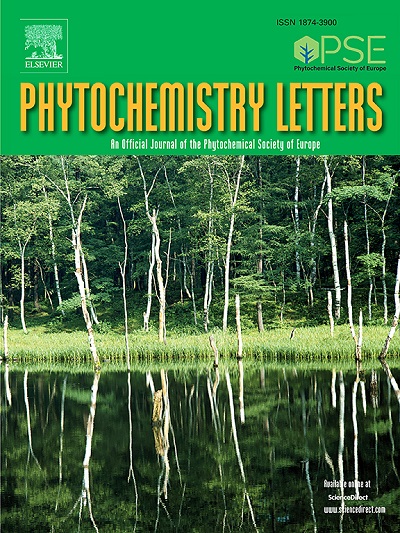Three new cycloartane and friedelane triterpenoids from the leaves of Caloncoba flagelliflora
IF 1.4
4区 生物学
Q4 CHEMISTRY, MEDICINAL
引用次数: 0
Abstract
Three previously undescribed triterpenoids, caloncobic acid D (1), caloncobalactone D (2), and trichadenic acid C (3) were isolated from the leaves of Caloncoba flagelliflora (Mildbr.) Gilg ex Pellegr. Additionally, seven known compounds, trichadonic acid (4), glaucalactone C (5), glaucanoic acid (6), friedelin (7), sitosterol (8), and stigmasterol (9), along with stigmasterol 3-O-β-D-glucopyranoside (10), were identified. The structures of these compounds were elucidated using spectroscopic methods, including extensive 1D and 2D NMR techniques, chemical evidence, and comparison with literature data. Subsequently, compounds 5–6 and 9–10 were evaluated for antiplasmodial activity against two strains of Plasmodium falciparum: PfDd2 and Pf3D7. Compound 6 exhibited moderate activity, with IC50 values of (7.5 ± 0.1 μM) and (10.0 ± 0.7 μM) against PfDd2 and Pf3D7, respectively. Compound 10 also moderately inhibited Pf3D7, with an IC50 value of (7.5 ± 0.1 μM). These findings highlight C. flagelliflora as a valuable source of triterpenes and suggest their potential as candidates for new antiplasmodial drug development.
从鞭毛蕨叶中分离出三个新的环artane和friedelane三萜
从Caloncoba flagelliflora (Mildbr.)的叶片中分离到三个先前未被描述的三萜类化合物,Caloncoba D(1)、caloncobalactone D(2)和trichadenic acid C(3)。Gilg ex Pellegr。此外,还鉴定出了七种已知化合物:三叉酸(4)、青核内酯C(5)、青核酸(6)、水杨酸(7)、谷甾醇(8)和豆甾醇(9),以及豆甾醇3-O-β- d -葡萄糖吡喃苷(10)。这些化合物的结构是通过光谱方法,包括广泛的一维和二维核磁共振技术,化学证据和文献数据的比较来阐明的。随后,化合物5 ~ 6和9 ~ 10对两株恶性疟原虫PfDd2和Pf3D7的抗疟原虫活性进行了评价。化合物6对PfDd2和Pf3D7的IC50值分别为(7.5 ± 0.1 μM)和(10.0 ± 0.7 μM)。化合物10对Pf3D7也有一定的抑制作用,IC50值为(7.5 ± 0.1 μM)。这些发现突出了鞭毛草是一种有价值的三萜来源,并表明它们有潜力作为新的抗疟原虫药物开发的候选者。
本文章由计算机程序翻译,如有差异,请以英文原文为准。
求助全文
约1分钟内获得全文
求助全文
来源期刊

Phytochemistry Letters
生物-生化与分子生物学
CiteScore
3.00
自引率
11.80%
发文量
190
审稿时长
34 days
期刊介绍:
Phytochemistry Letters invites rapid communications on all aspects of natural product research including:
• Structural elucidation of natural products
• Analytical evaluation of herbal medicines
• Clinical efficacy, safety and pharmacovigilance of herbal medicines
• Natural product biosynthesis
• Natural product synthesis and chemical modification
• Natural product metabolism
• Chemical ecology
• Biotechnology
• Bioassay-guided isolation
• Pharmacognosy
• Pharmacology of natural products
• Metabolomics
• Ethnobotany and traditional usage
• Genetics of natural products
Manuscripts that detail the isolation of just one new compound are not substantial enough to be sent out of review and are out of scope. Furthermore, where pharmacology has been performed on one new compound to increase the amount of novel data, the pharmacology must be substantial and/or related to the medicinal use of the producing organism.
 求助内容:
求助内容: 应助结果提醒方式:
应助结果提醒方式:


